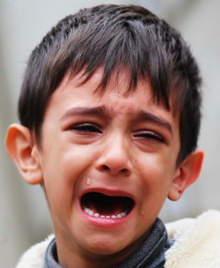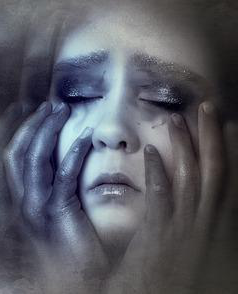Part Four — The Seven Universal Emotions
 Just as an artist mixes shades and tones of different paints to get just the right hue, so do we write scenes and characters to get just the right emotional response from our readers.
Just as an artist mixes shades and tones of different paints to get just the right hue, so do we write scenes and characters to get just the right emotional response from our readers.
Each of the seven universal emotions, surprise, anger, sadness, happiness, disgust, fear and contempt, represents a spectrum or family of different feelings. We have many different words to describe feelings that are similar but vary in the degree of their intensity.
Also, we must remember that emotions never happen in isolation. There are always layers of other emotions that help to add nuance to the primary emotion. Writers need to be aware of these nuances and write them accurately, so our readers will recognize the mixed feelings, the confusion, and the thoughts and motivations of our characters.
Sadness
![]()

Sadness is a universal cry for help. It is important in signalling a need to receive help or comfort, It communicates that we need comforting, time to process our loss or grief, and is a message to others that we are not able to participate normally. It’s also a message to ourselves to take time to heal and recover.
Sadness is Triggered by Loss
Sadness varies greatly based on one’s personal and cultural understanding of loss — loss of a valued person, a mate, friend, family member, or pet; loss of a home, a job or some treasured possession; disappointment at an unexpected outcome; times of major life transition; perhaps a loss of self-esteem or a reduction in social status; the loss of some aspect of our self-identity, or a physical or mental ability.
All of these can cause us sadness, and when several losses pile up on one another, the feeling of sadness increases and we shut down.
The emotion of sadness isn’t experienced in isolation. It can also be felt along with other emotions like anger and fear. It can even be felt along with happiness or nostalgia, while looking at old photos and remembering a lost loved one, or being comforted in our grief with a hug from a friend, or receiving a thoughtful card or letter.
What to Look For
 Facial expressions of sadness can be:
Facial expressions of sadness can be:
- Corners of the mouth are pulled down
- Inner corners of the eyebrows are pulled up and together (difficult to fake)
- Upper eyelids droop
- Lower lip may be pushed out
Physiological Responses
Emotions begin in the amygdala. This is the so-called “lizard brain”, responsible for identifying threats. It sends out an alarm which alerts us to protect ourselves. This process happens so rapidly that we react before we can make a conscious decision or even consider the consequences of our actions.
Bodily reactions of sadness can be:
- Loss of muscle tone
- Trouble sleeping
- Can increase sensitivity to cold
- Affects appetite
- Suppresses the immune system
- Increases stress and the release of the hormone cortisol
- More susceptible to illness and disease
What the Character Feels
The physical characteristics of sadness are:
- Tightness in the chest
- Heaviness of the limbs
- Stinging in the throat
- Watery eyes
- Loss of interest in normal activities
What the Character Does

- Posture droops (weight of the world)
- Lowering or hunching shoulders, folding in on oneself
- Looking away and/or downwards
- Avoiding eye contact
- Weeping
- Drink alcohol or take drugs to dull the pain
- May lash out when someone tries to comfort them
Subsequent reaction (after initial processing):
- Voice may become softer or lower-pitched
- Voice may become louder as in a wail or lament
- Some may seek out situation that make them sad in order to manipulate those around them.
- Some may avoid situations that might trigger sadness, becoming commitment-phobic on the off-chance that a relationship might end, thus making them sad.
The Spectrum of Sadness (from weakest to strongest)
- Disappointment
- Discouragement
- Distraughtness
- Resignation
- Helplessness
- Hopelessness
- Misery
- Despair
- Grief
- Sorrow
- Anguish
- Suicidal
Sadness Triggers
 Sadness is caused by loss. It may be loss of a relationship, loss of security, loss of something valued, or loss of a physical or mental ability. Disappointment at an unexpected outcome is also a kind of loss and can create a feeling of sadness.
Sadness is caused by loss. It may be loss of a relationship, loss of security, loss of something valued, or loss of a physical or mental ability. Disappointment at an unexpected outcome is also a kind of loss and can create a feeling of sadness.
- Loss of a valued person
- Rejection by a friend or lover
- Sickness or death of a loved one
- A mate
- A friend
- A family member
- A pet
- Loss of possessions
- A home
- A job or career
- A treasured object
- A financial loss
- Loss of some aspect of our self-identity
- Loss of self-esteem
- A reduction in social status
- Loss of a physical or mental ability
- During times of major life transition
- Leaving for college
- Divorce
- Exile
- Isolation
- Being disappointed by an unexpected outcome
- Situations that don’t turn out how we planned can feel as if we’ve been cheated or lost something important.
- During times of major life transition
- Leaving for college
- Divorce
- Exile
- Isolation
- Endings and goodbyes
- Separation
Types of Sadness and How to Use Them in Storytelling
We need to find a way to release the stress and anxiety when we’re sad.
Crying can make us feel better, so if our character needs to process grief or loss, we could write them having a crying jag or a quiet weep to let go of the emotion. After a crying jag, the brain secretes endorphins that help relax us. This could help slow the pace of the story after a moment of high suspense or action.
 The comfort offered by others can also make us feel better. The “perennial victim” or “poor me” personality has become dependent on this comfort, so they create “victim” scenarios, so they can continue to be comforted. Realization of this unpleasant aspect of one’s personality could be the turning point in a character’s transformation from victim to hero.
The comfort offered by others can also make us feel better. The “perennial victim” or “poor me” personality has become dependent on this comfort, so they create “victim” scenarios, so they can continue to be comforted. Realization of this unpleasant aspect of one’s personality could be the turning point in a character’s transformation from victim to hero.
Comfort can also be rejected by the one feeling sad, creating conflict and a feeling of distance in the character offering support.
Alternatively, we can create protagonists who have been hurt in the past and are so determined not to feel such vulnerability and sadness again that they avoid all commitments and entanglements. This can provide necessary story conflict, particularly in relationship-based plots and scenarios based on romance.
To create a realistic character, the writer can use the spectrum of sadness as an effective way to build his character arc. Someone who spirals into a deep, clinical depression doesn’t begin that way. This kind of progressive instability results from a sequence of experiences that pull the victim deeper and deeper until it feels like there’s no way out. In this type of storyline, the character can repeatedly be buffeted by circumstances that drive him further down through each subsequent level on the sadness spectrum until he either succumbs or confronts his demons and inner conflicts. Since character transformation is a critical part of story resolution, sadness can be an essential part of that transformation.
![]()
For the next several weeks, we’ll explore each of the Seven Universal Expressions Of Emotion. Next time, we’ll cover Fear.
If this information is helpful useful or simply interesting to you, please leave a comment below and let me know. I’d love to hear from you.
Happy Writing!
Related Posts:
Beverley Hanna
Trained as an artist in the late 1960’s and early 1970’s, I was one of the first creatives to be employed in the computer graphics industry in Toronto during the early 1980’s. For several years, I exhibited my animal portraiture in Canada and the U.S. but when my parents needed care, I began writing as a way to stay close to them. I’ve been writing ever since. I run a highly successful local writer’s circle, teaching the craft and techniques of good writing. Many of my students have gone on to publish works of their own. I create courses aimed at seniors who wish to write memoirs, with a focus on the psychology of creatives and the alleviation of procrastination and writer's block.
